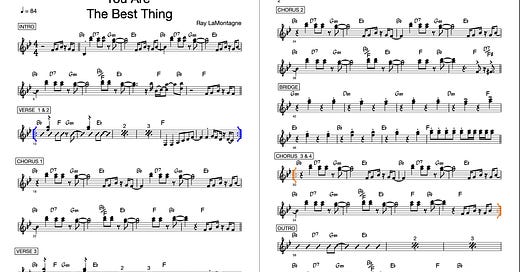RIFFS:
It’s like kicking a ball uphill.
When you stop kicking, it rolls backwards.
These temporary gains are so frustrating:
The songs you once knew.
The speed you previously had.
The resilience you used to have.
But what about the opposite?
What about improvements that ratchet?
The ability to hear when you’re out of tune,
or when your time feel isn’t gelling with the band.
The convergence between your hands and your mind,
or the higher standards that come from playing with badasses.
These things aren’t just improvements in and of themselves.
They enable further improvements.
(Usually in ways that were previously unimaginable.)
Can we reverse-engineer these?
Maybe.
Here’s what I noticed about my own ratchet clicks.
For each of my biggest jumps, I let something(s) go:
comfort (temporarily)
free time (temporarily)
the small-town dilettante attitude
embarrassment about my own ambition
pessimism about my own abilities1
And I added the things you’d expect:
had a deadline
got real organized
logged a shit-ton of hours
surrounded myself with higher-quality peers
tightened my feedback loops
and raised my own standards
The biggest jumps didn’t come from the highest effort.
They didn’t come from the tightest deadlines.
They didn’t come from having the highest-quality peers.
The biggest jumps came from:
Organizing my time…
Raising my standards…
And tightening my feedback loops.
If you’d like help with those things, there’s a free course for you here:
RECS:
It’s almost Black Friday season.
My favorite BF purchase of the last few years?
The Artist Bundle from Yurt Rock.
It’s ~40GB of top-notch loops & samples from legends like:
Clyde Stubblefield
Charlie Hunter
Tim LeFebvre
Mike Clark
Antonio Sanchez
Makes practicing an awful lot of fun.
I probably use the Wally Ingram pack the most.
Doesn’t look like it’s on sale just yet…
…but it’s worth getting on their email list to be notified when it is.
CHARTS:
Must-Know November continues!
Last week we learned September:
Today we’re learning Ray LaMontagne’s You Are The Best Thing.
Subscribe so you don’t miss the next Must-Know:
SMARTS:
1
It’s in B♭:
2
There’s a pickup measure:
In the simplest terms, that just means we don’t start on beat 1.
(If you wanna raise your rhythm IQ, check out RhythmOS.)
3
The drummer will should “give us the time” before counting us in.
Because it’s not terribly fast (84bpm), hopefully they’ll play 8th notes while giving us the time. That’ll help us more than quarter notes will (so we’re all in the groove right out of the gate).
Might sound like this:
4
Mind these subtle variations:
Notice that in the blue boxes, the last two melody notes descend.
But in the red boxes those last two melody notes ascend.
Here in the INTRO, you’re playing unison with the horns. They’re gonna play it correctly! Be part of the horn section here, and play what’s written.
In the CHORUS you play this same basic figure, but the horns don’t. So if you mess up there… no one will notice. 😆
5
Electric guitar vs acoustic guitar.
The acoustic guitar, bass, & drums all play these hits:
But the electric guitar only plays the little stab on beat 2:
Depending on the instrumentation of your band, you might need to cover both.
That’s all I got this week.
See you next Wednesday,
Josh
Side note:
If you measure your current self against where you’d like to be, it can be disheartening… and often detrimental to further progress.
But if instead you measure how far you’ve come, it’ll boost your confidence to keep going.











